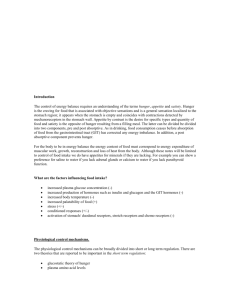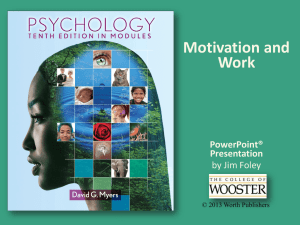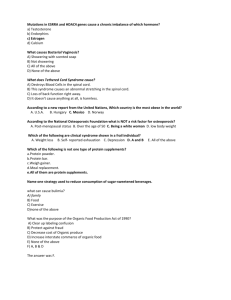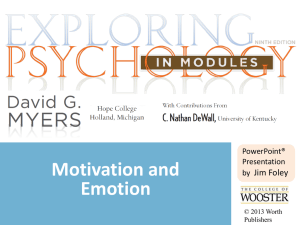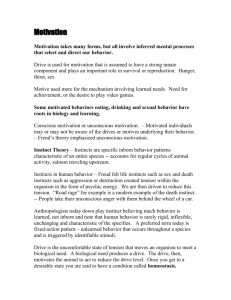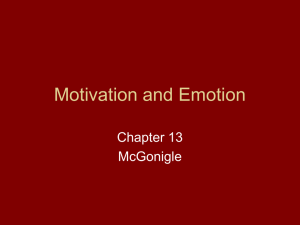Gastro04-RegulationOfFeeding.doc
advertisement
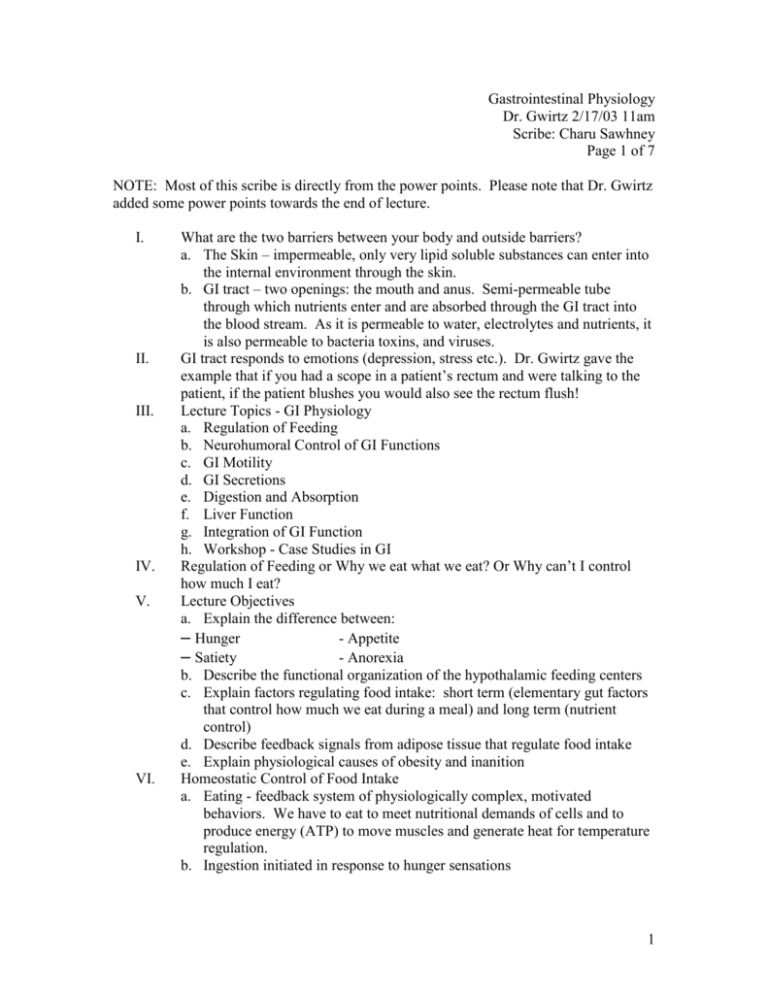
Gastrointestinal Physiology Dr. Gwirtz 2/17/03 11am Scribe: Charu Sawhney Page 1 of 7 NOTE: Most of this scribe is directly from the power points. Please note that Dr. Gwirtz added some power points towards the end of lecture. I. II. III. IV. V. VI. What are the two barriers between your body and outside barriers? a. The Skin – impermeable, only very lipid soluble substances can enter into the internal environment through the skin. b. GI tract – two openings: the mouth and anus. Semi-permeable tube through which nutrients enter and are absorbed through the GI tract into the blood stream. As it is permeable to water, electrolytes and nutrients, it is also permeable to bacteria toxins, and viruses. GI tract responds to emotions (depression, stress etc.). Dr. Gwirtz gave the example that if you had a scope in a patient’s rectum and were talking to the patient, if the patient blushes you would also see the rectum flush! Lecture Topics - GI Physiology a. Regulation of Feeding b. Neurohumoral Control of GI Functions c. GI Motility d. GI Secretions e. Digestion and Absorption f. Liver Function g. Integration of GI Function h. Workshop - Case Studies in GI Regulation of Feeding or Why we eat what we eat? Or Why can’t I control how much I eat? Lecture Objectives a. Explain the difference between: – Hunger - Appetite – Satiety - Anorexia b. Describe the functional organization of the hypothalamic feeding centers c. Explain factors regulating food intake: short term (elementary gut factors that control how much we eat during a meal) and long term (nutrient control) d. Describe feedback signals from adipose tissue that regulate food intake e. Explain physiological causes of obesity and inanition Homeostatic Control of Food Intake a. Eating - feedback system of physiologically complex, motivated behaviors. We have to eat to meet nutritional demands of cells and to produce energy (ATP) to move muscles and generate heat for temperature regulation. b. Ingestion initiated in response to hunger sensations 1 VII. VIII. IX. X. XI. c. Continues while total quantity and specific nourishment of ingested food is monitored d. Repletion of nutrients causes satiation e. Animals in the wild only eat enough to meet their needs; humans also eat for emotional reasons. Intake of food should be adequate to meet metabolic need of tissues, if in excess obesity will result. Homeostatic Control of Food Intake – During inter-digestive period, endogenous fuel is depleted, satiety wanes, hunger and/or nutrient depletion initiates another meal. Get knawing feeling in stomach and begin foodseeking behavior. Definitions: a. Hunger - craving for food - objective or physiological awareness of the need to ingest food; associated with objective sensations such as malaise, hunger contractions and subjective sensations due to low levels of nutrients in blood b. Appetite - implies the desire for a specific type or quality of food. Includes the desire to eat even when hunger has been appeased. Can be based on emotion, habit, and cultural influences. c. Satiety - opposite of hunger; feeling of fulfillment in the great quest for food. Results from ingestion of a meal in a normal individual. Amount of food causing satiety depends, in part, on whether energy stores are full d. Anorexia - aversion to eating. May be due to a psychological or pathological abnormality Regulation of Body Weight: a. Body is concerned with regulation of adiposity; it needs to maintain a certain amount of body fat b. Set point theory - any change in adiposity is compared with an internally set standard for adiposity i. The feedback response is relative to the measured deviation from this set point ii. Feedback elicits a proportional metabolic or behavioral response, which then opposes the measured deviation from the set point Regulation of Body Weight: a. Set-range model i. Deviation of weight within an acceptable range above or below usual weight ii. Maintenance of weight within this acceptable range can be controlled by dietary habits, short-term (meal-to-meal) regulation, or both Regulation of Body Weight a. Deviation of weight outside this acceptable range would initiate more potent, long-term regulatory systems instead of (or in addition to) the short-term regulators. b. Set point/range model - body tries to stabilize body weight or adiposity 2 c. Body weight set point/range changes readily with changes in physical activity, dietary composition (high fat diet), emotional state, stress, pregnancy, etc. - not strictly controlled XII. What Starts a Meal? Hunger Factors a. Habit: time to eat (meal schedule); some people are used to eating three meals a day etc. b. Presence of appetizing food: appearance, odor, taste, texture, temperature of food c. Other people eating d. Signal to brain that supply of nutrient/s low: protein, glucose, fatty acids i. Protein and CHO stores relatively constant; adipose stores may change markedly in adults XIII. What Stops a Meal? Satiety Factors a. Head Factors: cues from sight, smell, taste, tactile sensations of a meal; total caloric monitoring. Also, the actual act of eating (chewing and swallowing) sends signals via the vagus to the hypothalamus to begin activating the satiety center. b. Gastric & Intestinal Factors: i. Distension; chemical signals c. Neural Mechanisms – brain stem and hypothalamus XIV. Control of Feeding Behavior – Refer to diagram in power points a. Hypothalamus controls how much we eat: hunger and satiety centers b. Ingest food moves through GI tract hormones are released distention of stomach and duodenum neural signals to satiety center which is stimulated inhibit hunger center c. Signals from the cerebral cortex can override signals to stop eating. This can be initiated with taste, smell and/or sight of food and emotions. d. Long term adipose mass secretes leptin hypothalamus stimulate satiety center XV. Central Regulation of Feeding a. Lateral Nuclei of Hypothalamus - Hunger Center b. Stimulation causes voracious eating (hyperphagia); bilateral lesions cause disinterest in food and weight loss (anorexia) c. Directly excites the emotional drive for to search for food and controls amount of food eaten d. Excites brain stem centers controlling chewing, salivation, swallowing e. Tonically active; inhibited by stimulation of the satiety center XVI. Central Regulation of Feeding a. Ventromedial Hypothalamus - Satiety Center b. Stimulation causes complete satiety – animal refuses to eat (aphagia) Complete destruction of satiety center causes a voracious appetite c. Bilateral lesions causes marked hyperphagia and obesity d. Putative satiety signals: CCK (hormone released by duodenum in response to fat: stimulates satiety center. Tried to make it a drug to control hunger, but when used it induced vomiting), leptin (via NPY), anorectin, amphetamines, ephedrine, meridia etc. 3 e. Acts by inhibiting the hunger/feeding center f. Many patients who have morbid obesity are thought to have a functional reorganization of the LH and VMH XVII. Other Neural Centers Involved With Regulation of Food Intake a. Actual mechanics of feeding (salivation, licking lips, chewing, swallowing) are controlled by centers in the brain stem b. Function of hypothalamus is to control quantity of food intake and to excite the lower centers (in brain stem) to activity c. Higher centers than the hypothalamus are also important in the control of feeding, especially control of appetite d. Amygdala - bilateral destruction causes a "psychic blindness” in choice & quality; don’t care what kind of food you eat! e. Prefrontal cortex, or cortical areas of the limbic system - areas responsible for determining quality of food that is ingested - remembers previous unpleasant experience (e.g., food poisoning) XVIII. Short Term – Alimentary Regulation a. Feeding stops prior to nutrient absorption - important regulators independent of stored energy i. Habit – know volume of food to eat ii. “Head” or “Oral” Factors: smell, taste, texture, chewing, salivation, swallowing “meter” amount of food being consumed (30 min) iii. Gastrointestinal Filling: distension of stomach and small intestine (volume; mechanoreceptors, stimulate hypothalamus by way of parasympathetic nerves) (1-2 hr) iv. Intestinal and Liver Factors: Hormonal Feedback: CCK (fat), glucagon, somatostatin, bombesin (gastrin-releasing peptide), Leptin (?) (2 hr) XIX. Intermediate and Long Term Regulation a. Glucostatic Theory - glucose utilization is an important regulator of hunger i. High blood glucose and/or high level of glucose metabolism stimulates the satiety center ii. There are insulin-dependent, glucose-sensitive neurons (glucostats) in the hypothalamus iii. Inter-meal low glucose use of neurons hunger eating until satiety signals terminate feeding when glucose use becomes high iv. Refer to power points for flow chart b. Aminostatic (Protein) Theory - levels of amino acid precursors (tryptophan, tyrosine, choline) can affect formation of their respective products such as serotonin, catecholamines, and acetylcholine i. These neurotransmitters may be critical to the central regulation of feeding and satiety ii. Most potent satiating nutrient c. Lipostatic Theory - Increasing plasma fatty acid levels while eating stimulates the satiety center 4 i. This hypothesis is supported by discovery of LH neurons that are sensitive to the application of free fatty acids ii. Least potent satiating nutrient iii. Body fat (especially TG) stores regulated variable and any deviation change in feeding behavior iv. Hypothalamic receptors monitor and regulate circulating levels of fat metabolites (fatty acids, glycerol, 3-hydroxybutyrate) which signal size of body fat stores v. Or in size of fat stores compensatory hypo- or hyperphagia and change in metabolic rate to restore body fat stores to normal size XX. Intermediate & Long Term Regulation: Nutrient Status a. Interrelation between body temperature and food intake i. When an animal is exposed to cold, it tends to overeat (insulation) ii. When animal is exposed to heat, it tends to under eat (get rid of body fat) iii. Caused by interaction within the hypothalamus between the temperature-regulating system and the food intake-regulating system iv. Important because increased food intake in the cold animal 1. Increases its metabolic rate 2. Provides increased fat for insulation, both of which tend to correct the cold state XXI. Long-Term Control a. Activated if short-term regulators fail & body weight deviates out of acceptable range b. Adipose mass - most likely regulated factor; search is for a signal proportional to adipose mass and has central effects on feeding c. Hypothalamus senses energy storage via actions of peptide hormone, leptin, which is released from adipocytes XXII. Relationship Between Fat, Leptin, NPY and Hunger a. Good flow chart in power points b. There might be a genetic defect in morbidly obese people where there is a decrease in leptin release from fat stores and where receptors in hypothalamus become more insensitive to leptin. This leads to hyperphagia and obesity. XXIII. Short Term & Long Term Control - Why Both? a. Long-term Regulation i. Helps maintain constant stores of nutrients in the tissues, preventing them from becoming too low or too high b. Short-term Regulation i. Make person eat smaller quantities at each eating session ii. Allows food to pass through GI tract at a steadier pace, so digestive and absorptive mechanisms can work at optimal rates rather than becoming periodically over- burdened 5 iii. Prevents person from eating amounts of food at each meal that would be too much for the metabolic storage systems once the food has all been absorbed XXIV. Obesity a. Results from greater energy intake than energy expenditure - we override control mechanisms b. When greater quantities of energy (in the form of food) enter the body than are expended, body weight increases c. Causes of Obesity i. Abnormality of Feeding Mechanism ii. Genetic - altered set point; fat chemistry iii. Environmental factors iv. Childhood overeating: once fat is deposited, obesity will be maintained by normal food intake v. Neurological 1. Morbid Obesity: hypothalamic/brainstem lesions; functional reorganization of brain centers vi. Psychological – when animals are force fed and are then allowed control of their eating habits, they will eat less until body fat back to normal. Inversely, if they are starved then they will eat more until body fat is back to normal. Humans don’t have this control due to emotional factors that affect eating XXV. Obesity – Related Health Problems a. Cardiovascular (arthrosclerosis, CAD) b. Diabetes c. Gallbladder disease from high lipid diet, can cause cholesterol stones d. Treatments: i. Diet/exercise ii. Pharmacological: amphetamines (temporarily works), fat absorption blockers (severe side affects) iii. Psychological Counseling iv. Surgery – Gastric bypass surgery or binding stomach. Patients can still gain weight by drinking high fat, high-energy milk shakes. XXVI. Inanition – Starvation a. Opposite of obesity i. Depletion of body stores of fat, protein, vitamins; electrolyte imbalance ii. High mortality b. Causes: i. Inadequate availability of food ii. Pharmacological treatments (chemotherapy) iii. Psychological abnormalities – anorexia nervosa, bulimia iv. Hypothalamic (neurological) abnormalities 1. Tumors, cancer 2. Stroke 3. Chemotherapy 6 XXVII. a. b. c. d. XXVIII. a. b. 4. Illness, fever Anorexia Nervosa Abnormal psychic state in which a person loses all desire for food and even becomes nauseated by food Bulimia i. Abuse of laxatives, emetics ii. Bingeing and purging Requires Psychotherapy i. 50% never cured Medical Problems: GI, Dental, CV, Electrolytes Cachexia Means severe inanition Due to destructive lesions of the hypothalamus i. Often caused by vascular thrombosis or tumors in some people 7
